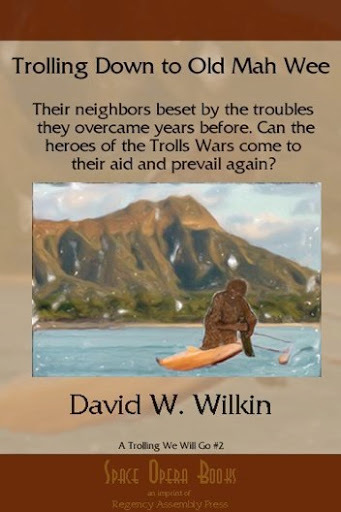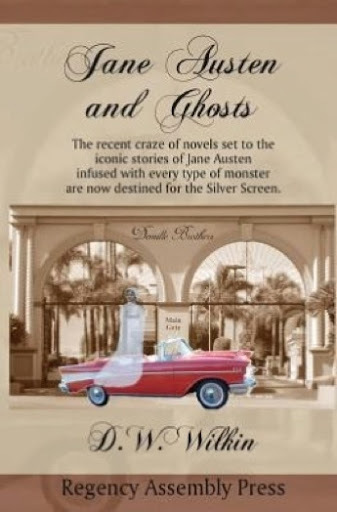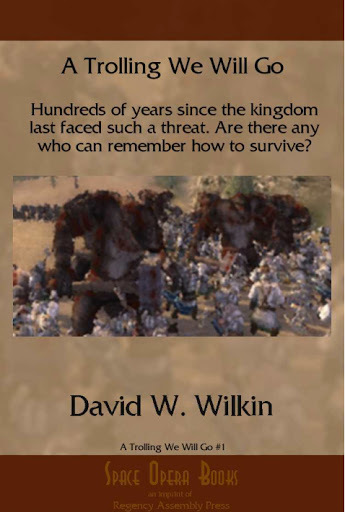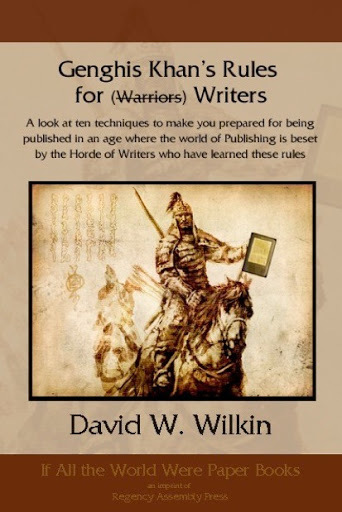D.W. Wilkin's Blog, page 23
October 5, 2016
Trolling Down to Old Mah Wee, another Fantasy
Trolling Down to Old Mah Wee
Not only do I write Regency and Romance, but I also have delved into Fantasy.
The Trolling series, (the first three are in print) is the story of a man, Humphrey. We meet him as he has left youth and become a man with a man’s responsibilities. We follow him in a series of stories that encompass the stages of life.
We see him when he starts his family, when he has older sons and the father son dynamic is tested. We see him when his children begin to marry and have children, and at the end of his life when those he has loved, and those who were his friends proceed him over the threshold into death.
All this while he serves a kingdom troubled by monsters. Troubles that he and his friends will learn to deal with and rectify. It is now available in a variety of formats.
For $2.99 you can get this 2nd book in the fantasy adventure series of Humphrey and Gwendolyn.
Barnes and Noble for your Nook
When the neighboring kingdom of Mah Wee begins to experience the same problems that beset Torahn some years before, they urgently request the aid of the experts in containing a new Troll infestation. But eradicating Trolls is not as easy as exterminating a few rats or mice.
Trolls are bigger than men, they are stronger than men, and then are meaner than men. Humphrey Cutter and his band of mismatched warriors must once again rise to the occasion, but can they without the aid of expertise of Gwendolyn and her particular skills?
Mah Wee, an ancient kingdom, with a monarch more steeped in the rights of being a king rather than the obligations and duties that a king should be. Here Humphrey and his crew finds that they have more than Trolls to overcome if they are to save Mah Wee from the same or nearly similar problems that they faced before in Torahn.
But, as Humphrey knows, nothing can truly be accomplished if the lovely Gwendolyn is not able to lend her aid as well.
Feedback
If you have any commentary, thoughts, ideas about the book (especially if you buy it, read it and like it
October 4, 2016
Regency Personalities Series-John James Waldegrave 6th Earl Waldegrave
Regency Personalities Series
In my attempts to provide us with the details of the Regency, today I continue with one of the many period notables.
Lieutenant-Colonel John James Waldegrave 6th Earl Waldegrave
31 July 1785 – 1835
Lieutenant-Colonel John James Waldegrave 6th Earl Waldegrave was a British peer and soldier.
Waldegrave was the second son of the 4th Earl Waldegrave and was educated at Eton. Upon his father’s death in 1789, Waldegrave’s elder brother George inherited the former’s titles, but Waldegrave soon inherited them (aged eight), when his brother drowned in the Thames five years later.
On leaving Eton in 1801, Lord Waldegrave purchased a commission in the 55th Foot. He later transferred to the 3rd Foot Guards and in 1804 transferred to the 39th Foot as a Lieutenant without purchase. He later transferred to the 36th Foot and exchanged into the 7th Light Dragoons in 1805. He saw action during the Peninsular War. In 1808 he transferred to the 8th Garrison Battalion as a Major and a few months later exchanged into the 72nd Foot. He exchanged into the 15th Light Dragoons in 1809 and into the 12th Light Dragoons in 1812. Eight months later he purchased the Lieutenant-Colonelcy of the 54th Foot, which he commanded at the Battle of Waterloo in 1815.
On his return home, he married his longtime lover, Anne King on 30 October 1815; they had had several children before their marriage and later had a further four. His daughter Lady Horatia married firstly in 1847 Capt. John Joseph II Webbe-Weston(d.1849) of Sutton Place, Surrey and secondly John Wardlaw, brother of General Wardlaw. Lord Waldegrave was briefly a Tory Lord of the Bedchamber from 1830–31 and died in 1835. He was succeeded by his eldest legitimate son, Hon. George Edward, and his wife remarried in 1839, to Dr. Algernon Hicks.
Waldegrave later transferred to the 98th Foot.


Jane Austen Fans Rejoice, Jane is BACKKKK… Jane Austen and Ghosts
Special Sale Price!
Jane Austen and Ghosts.
Not only do I write Regency and Romance, but this can take a humorous turn. Some years back, I am sure readers of this blog will be aware that some writers began to take great liberty with Jane Austen and her works. Pride and Prejudice being liberally rewritten with the inclusion of zombies.
Then other books appeared with sea monsters, and werewolves and vampires. President Lincoln has even made it to the big screen where he is intent on sending foul creatures to hell. It occurred to me, even before I read any of this literature, that Jane would probably not appreciate what had been done to her classic piece.
That the tales and her life have become visual spectacles that we enjoy she might not like either, but is perhaps resigned to. That zombies, ghosts and vampires are now used to follow her own plot lines would I think, have her turning over in her grave. Jane Austen and Ghosts is my take on that.
It is now available in a variety of formats. For a limited time it has been reduced to $2.99 for your eReaders and $8.99 for paperback you can get this Jane Austen adventure.
Barnes and Noble for your Nook
and in Paperback
In the world of moviemaking, nothing is as golden as rebooting a classic tale that has made fortunes every time before when it has been adapted for the silver screen.
Certainly any work by Jane Austen made into a movie will not only be bankable, but also considered a work of art. That is of course until the current wave of adaptations that unite her classic stories with all the elements of the afterlife is attempted to be created.
That these have found success in the marketplace amongst booklovers may not be quite understood by those who make movies. But that they are a success is understood and a reason to make them into movies.
All that being said, perhaps it would also be fair to say that the very proper Jane, were she present to have anything to say about it, would not be pleased. Of course she has been away from this Earth for nearly 200 hundred years.
But does that mean were she upset enough, she wouldn’t come back?
Feedback
If you have any commentary, thoughts, ideas about the book (especially if you buy it, read it and like it
October 3, 2016
Regency Personalities Series-Anne Marsh-Caldwell
Regency Personalities Series
In my attempts to provide us with the details of the Regency, today I continue with one of the many period notables.
Anne Marsh-Caldwell
1791 – 5 October 1874
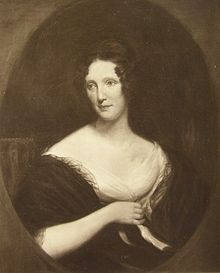
Anne Marsh-Caldwell
Anne Marsh-Caldwell was the third daughter and fourth child of James Caldwell, J.P., of Linley Wood, Staffordshire, who was recorder of Newcastle-under-Lyme, and deputy-lieutenant of the county; her mother was Elizabeth, daughter and coheiress of Thomas Stamford of Derby. In July 1817 she married Arthur Cuthbert Marsh, latterly of Eastbury Lodge, Hertfordshire.
Arthur Cuthbert Marsh (died 23 December 1849) was son of William Marsh, senior and sleeping partner in the London banking firm of Marsh, Stacey, & Graham, ruined in 1824 by Henry Fauntleroy, a junior partner. There were seven children of the marriage. On the death of her brother, James Stamford Caldwell, in 1858, Anne Marsh succeeded to the estate of Linley Wood, and resumed by royal licence the surname of Caldwell in addition to that of Marsh. She died at Linley Wood, 5 October 1874.
Anne Marsh was one of the most popular British novelists, for nearly a quarter of a century. Her first book, Two Old Men’s Tales, was made up of two stories, The Deformed and The Admiral’s Daughter. It was published at the suggestion of Harriet Martineau. Recognised as didactic in character, her books were published anonymously and mainly describe life in the upper middle class and the lower ranks of the aristocracy. They include the following:
Two Old Men’s Tales, 1834.
Tales of the Woods and Fields, 1838.
Triumphs of Time, 1844.
Aubrey, 1845.
Mount Sorel, 1845.
Father Darcy, an Historical Romance, 1846.
Emilia Wyndham, 1846,
Norman’s Bridge, or the Modern Midas, 1847.
Angela, or the Captain’s Daughter, 1848.
The Previsions of Lady Evelyn.
Mordaunt Hall, 1849.
The Wilmingtons, 1849.
Lettice Arnold, 1850.
Time the Avenger, 1851.
Ravenscliffe, 1851.
Castle Avon, 1852.
The Heiress of Haughton, 1856.
Evelyn Marston, 1856.
The Rose of Ashurst, 1867.
Many of these works passed through several editions. A collection of them, in 15 volumes, was published in Thomas Hodgson’s Parlour Library, 1857. Marsh wrote also The Protestant Reformation in France and the Huguenots (1847), and a translation of the Song of Roland, as chanted before the Battle of Hastings by the minstrel Taillefer (1854).
Marsh has been wrongly credited with novels written by Julia Cecilia Stretton (1812–1878), such as Margaret and her Bridesmaids.


Space Opera Books Presents A Trolling We Will Go (Book #1)
A Trolling We Will Go
Not only do I write Regency and Romance, but I also have delved into Fantasy.
The Trolling series, (the first three are in print) is the story of a man, Humphrey. We meet him as he has left youth and become a man with a man’s responsibilities. We follow him in a series of stories that encompass the stages of life.
We see him when he starts his family, when he has older sons and the father son dynamic is tested. We see him when his children begin to marry and have children, and at the end of his life when those he has loved, and those who were his friends proceed him over the threshold into death.
All this while he serves a kingdom troubled by monsters. Troubles that he and his friends will learn to deal with and rectify.
It is now available in a variety of formats. For $.99 you can get this fantasy adventure.
Barnes and Noble for your Nook
The Valley Kingdom of Torahn had been at peace for fifty years since the Council of Twenty-One saw fit to dispense with their royal family.
The only Kingdom without a King on the west side of the continent. But late last year, something caused the Goblins in the Old Forest, Karasbahn to stir and act courageous.
Something that men can not remember seeing Goblins ever doing. What has gotten the Goblins in such a state?
Whatever it is, it can not be good news for Torahn. Or for Humphrey, a woodcutter for a small town, far from Karasbahn.
But part of the Kingdom’s militia, with no family or other exemptions. He is perfect to be sent to the Old Forest and find out what scares the Goblins that they have become fearless.
Feedback
If you have any commentary, thoughts, ideas about the book (especially if you buy it, read it and like it
October 2, 2016
Regency Personalities Series-Stephen Groombridge
Regency Personalities Series
In my attempts to provide us with the details of the Regency, today I continue with one of the many period notables.
Stephen Groombridge
7 January 1755 – 30 March 1832
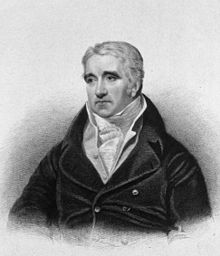
Stephen Groombridge
Stephen Groombridge was born at Goudhurst in Kent on 7 January 1755. He succeeded when about 21 to the business in West Smithfield of a linendraper named Greenland, to whom he had been apprenticed. Later, and until 1816, he was a successful West India merchant. He lived mainly at Goudhurst, where he built a small observatory; but moved to Blackheath in 1802.
In 1806, using a then new transit circle built by Edward Troughton, he began compiling a star catalogue of stars down to about eighth or ninth magnitude. He spent ten years making observations on the Groombridge Transit Circle and another ten years doing reductions of the data (correcting for refraction, instrument error and clock error). In 1827 he suffered a “severe attack of paralysis” from which he never fully recovered. Others continued the work, continuing with corrections for aberration and nutation among others.
Groombridge died in Blackheath. His Catalogue of Circumpolar Stars was published posthumously in 1838 with the help of fellow astronomer George Biddell Airy (1801–1892) and others. An earlier edition had been published in 1833 but was found to contain errors and was withdrawn. In 1842, one of the stars in his catalogue, Groombridge 1830, was discovered by Friedrich Wilhelm Argelander to have a very high proper motion. For many decades its proper motion was the highest known; today it still occupies third place.
Groombridge, Stephen (1838). A Catalogue of Circumpolar Stars. London: John Murray.- edited by George Biddell Airy; has biographical information for Groombridge


RAP (Regency Assembly Press) in need of Beta-Readers
Regency Assembly
Press
is looking for
Beta Readers
One novel is ready for Beta Reading
We have a continuation of Pride and Prejudice with Ms Caroline Bingley and her fortune at stake:
Do we think that Mr Hurst married his Bingley Bride without incentive? It is highly probable that Caroline Bingley, even though she has a sharp, acerbic tongue, still is in possession of a fortune and an astute fortune hunter who deciphers this may soon be on the road to, if not a happy marriage, one with financial security.
Please respond or send an email if you are interested


Rules for better writing from Genghis Khan
The Rules for Writers
Those who follow me for a long time know that I also write in other fields aside from Regency Romance and the historical novels I do.
A little while ago, before the end of 2011 and the 2011 NaNoWriMo, (where I wrote the first draft of another Regency) I started work on a project about writing.
The premise was what one should think about when starting and working on a project. I came up with 10 rules to follow in a quest to become a writer and tackle that novel.
Here are The 10 Rules:
1) Read like a writer
2) Have a good story
3) Your work will be Thematic
4) Plot: The seven deadly ones
5) Characters will carry your tale, near and far
6) Words are your warriors
7) Stories are structured
8) All tales building to a Crescendo
9) Genghis edits history, shouldn’t you as well
10) Act like a writer
So it is now released. For $4.99 you can get this treatise on honing your skills.
Barnes and Noble for your Nook
Genghis Khan came from the Steppes of Mongolia, a family torn apart by neighboring tribes, to unite those tribes, or defeat them, and then conquer the greater part of the known world. His heirs would continue his conquest right to the edge of western society. The world feared the Mongols, and Genghis. Now, you can benefit, as a writer from the lessons he has to impart on how, with the changing world of publishing, you can perfect your work and write not only good material for this new age of book publishing. But can write great work for this new age. 10 simple lessons, and you will be on your way to conquering the bookshelves of the 21st century. This short book will have you learning all you really need to know to elevate your writing to the next level. These simple lessons will start you on the road to better writing as a member of the Horde in no time.
Feedback
If you have any commentary, thoughts, ideas about the book (especially if you buy it, read it and like it
October 1, 2016
Regency Personalities Series-Geographical Society of London (1830)
Regency Personalities Series
In my attempts to provide us with the details of the Regency, today I continue with one of the many period notables.
Geographical Society of London (1830)
1830 –
The Geographical Society of London was founded in 1830 under the name Geographical Society of London as an institution to promote the ‘advancement of geographical science’. It later absorbed the older African Association, which had been founded by Sir Joseph Banks in 1788, as well as the Raleigh Club and the Palestine Association.
Like many learned societies, it had started as a dining club in London, where select members held informal dinner debates on current scientific issues and ideas.
Founding members of the Society included Sir John Barrow, Sir John Franklin and Sir Francis Beaufort. Under the patronage of King William IV it later became known as The Royal Geographical Society (RGS) and was granted its Royal Charter under Queen Victoria in 1859.
From 1830 – 1840 the RGS met in the rooms of the Horticultural Society in Regent Street.
The history of the Society was closely allied for many of its earlier years with ‘colonial’ exploration in Africa, the Indian subcontinent, the polar regions, and central Asia especially.
It has been a key associate and supporter of many notable explorers and expeditions, including those of Darwin, Livingstone, Stanley, Scott, Shackleton, Hunt and Hillary.
The early history of the Society is inter-linked with the history of British Geography, exploration and discovery. Information, maps, charts and knowledge gathered on expeditions was sent to the RGS, making up its now unique geographical collections. The Society published its first journal in 1831.
The society also presents many awards to geographers that have contributed to the advancement of geography.
The most prestigious of these awards are the Gold Medals (Founder’s Medal 1830 and the Patron’s Medal 1838). The award is given for “the encouragement and promotion of geographical science and discovery”. The awards originated as an annual gift of fifty guineas from King William IV, first made in 1831, “to constitute a premium for the encouragement and promotion of geographical science and discovery”.
Presidents
Frederick John Robinson, 1st Viscount Goderich The Earl of Ripon (1830–1833) (first president)
Sir George Murray (1833–1835)


An Unofficial Guide to how to win the Scenarios of Rollercoaster Tycoon 3
An Unofficial Guide to how to win the Scenarios of Rollercoaster Tycoon 3
I have been a fan of this series of computer games since early in its release of the very first game. That game was done by one programmer, Chris Sawyer, and it was the first I recall of an internet hit. Websites were put up in dedication to this game where people showed off their creations, based on real amusement parks. These sites were funded by individuals, an expense that was not necessarily as cheap then as it is now. Nor as easy to program then as it might be to build a web page now.
Prima Books released game guides for each iteration of the game, Rollercoaster Tycoon 1, Rollercoaster Tycoon 2 and Rollercoaster Tycoon 3 (RCT3) but not for the expansion sets. And unlike the first two works, the third guide was riddle with incorrect solutions. As I played the game that frustrated me. And I took to the forums that Atari, the game publisher hosted to see if I could find a way to solve those scenarios that the Prima Guide had written up in error. Not finding any good advice, I created my own for the scenarios that the “Official” Guide had gotten wrong.
Solutions that if you followed my advice you would win the scenario and move on. But if you followed the
“Official” version you would fail and not be able to complete the game. My style and format being different than the folks at Prima, I continued for all the Scenarios that they had gotten right as well, though my solutions cut to the chase and got you to the winner’s circle more quickly, more directly.
My contributions to the “Official” Forum, got me a place as a playtester for both expansions to the game, Soaked and Wild. And for each of these games, I wrote the guides during the play testing phase so all the play testers could solve the scenarios, and then once again after the official release to make changes in the formula in case our aiding to perfect the game had changed matters. For this, Atari and Frontier (the actual programmers of the game) placed me within the game itself.
And for the longest time, these have been free at the “Official” Forums, as well as my own website dedicated to the game. But a short time ago, I noticed that Atari, after one of its bankruptcies had deleted their forums. So now I am releasing the Guide for one and all. I have added new material and it is near 100 pages, just for the first of the three games. It is available for the Kindle at present for $2.99.
(Click on the picture to purchase)
Not only are all 18 Scenarios covered, but there are sections covering every Cheat Code, Custom Scenery, the famous Small Park Competition, the Advanced Fireworks Editor, the Flying Camera Route Editor which are all the techniques every amusement park designer needs to make a fantastic park in Rollercoaster Tycoon 3.
Scenarios for RCT 3
1) Vanilla Hills
2) Goldrush
3) Checkered Flag
4) Box Office
5) Fright Night
6) Go With The Flow
7) Broom Lake
8) Valley of Kings
9) Gunslinger
10) Ghost Town
11) National Treasure
12) New Blood
13) Island Hopping
14) Cosmic Crags
15) La La Land
16) Mountain Rescue
17) The Money Pit
18) Paradise Island



